
As business owners, we know that we should be curating customer reviews as much as possible online.
One could say mastering the review process alone means more customers (both in and outside of Google My Business).
Before we dive in too far, let’s look at some key customer review statistics:
- 82% of consumers read online reviews for local businesses, with 52% of 18-54-year-olds saying they ‘always’ read reviews [Source: Bright local]
- The average consumer reads 10 reviews before feeling able to trust a business [Source: Bright local]
- Only 53% of people would consider using a business with less than 4 stars
[Source: Bright local] - The average consumer spends 13 minutes and 45 seconds reading reviews before making a decision [Source: Bright local]
- Among consumers that read reviews, 97% read businesses’ responses to reviews [Source: Bright local]
But why do people leave reviews?
What are the motivations behind them, and why are they important to our business and our digital presence?
People generally leave a review because of one of these two motivations:
- Share experiences and promote or support a brand
- Warn consumers about a bad experience they had
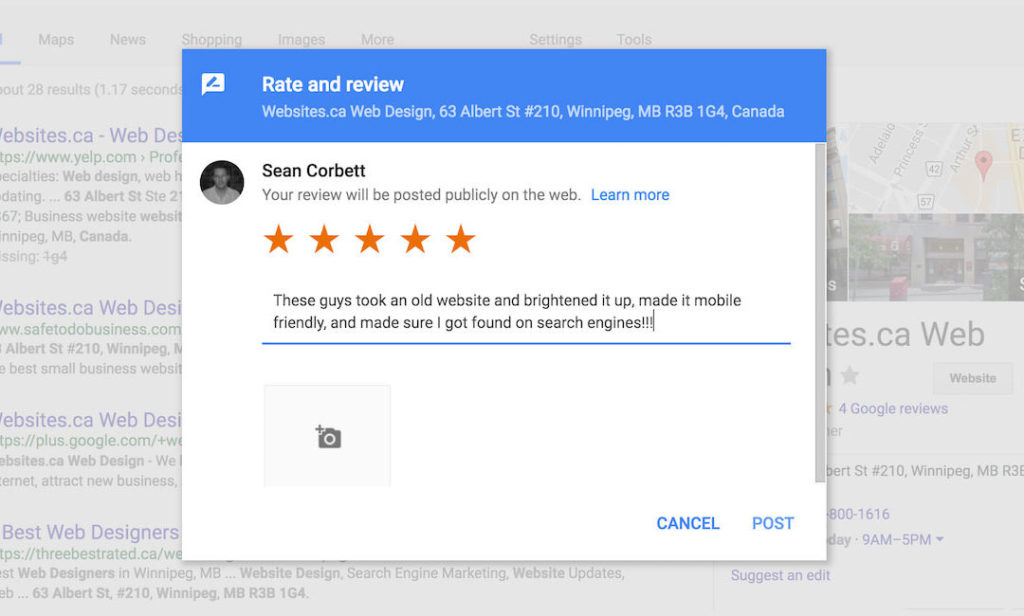
As a business then, what do we do when someone leaves a review, what is the appropriate response?
Many businesses will only be motivated to respond to negative reviews and not positive, 4-5 star reviews or maybe even worse they won’t respond to any at all. More on this later on.
Reviews As a Local SEO Ranking Factor
It’s important to mention when talking about reviews that reviews are more than just a virtual popularity contest identifiable by a handful of yellow stars.
Reviews are also:
- An important ranking factor in local SEO
- A driving force behind determining the visibility of your Google My Business listing
- Social proof
- Show the overall health of your company in a review-driven economy
As mentioned, reviews are an important ranking factor when it comes to local SEO. As you can see from the chart below, reviews alone account for 13% of the local ranking signal to Google’s Local Pack/Finder when a local intent search query is performed according to Moz’s 2018 Local Search Ranking Factors survey.
What is a local intent search query? If you’ve ever searched for a pizza joint near your home, you’re probably more familiar with them then you know. A classic example would look like this: “Pizza Shop Near Me” or “Pizza Shop Hamilton, ON”.
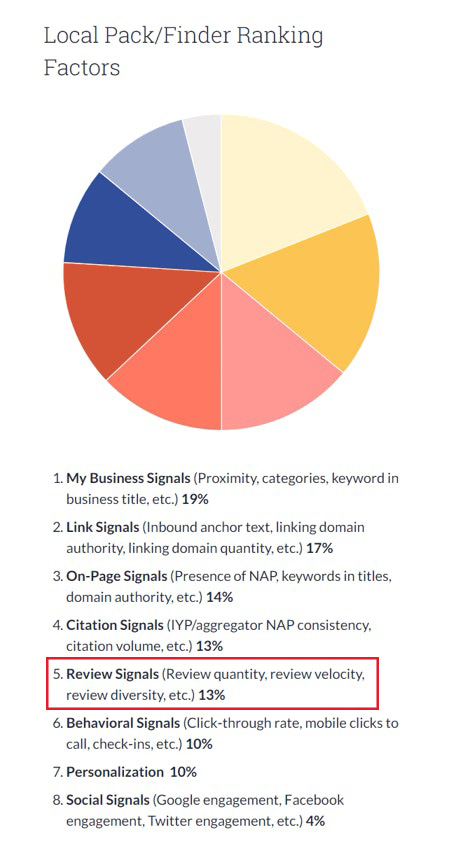
And below is the typical result you get back from Google when you’re looking for a “Pizza Shop Near Me” or any other similar local intent search query. Three business listings accompanied by a map and a “More Places” button below. This is local SEO in action.
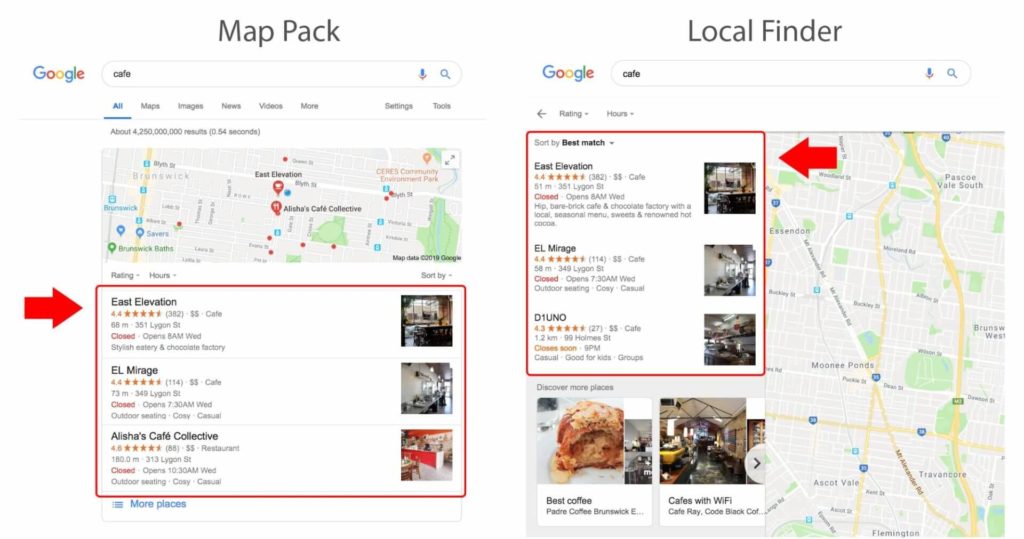
How Review Recency and Velocity Impact Local SEO and Consumer Behaviour
You’ll notice in the pie chart above from MOZ, review velocity is mentioned under “#5 Review Signals”. Review recency or velocity simply refers to the frequency in which customers leave reviews and is an attribute of reviews themselves. One Bright Local survey found reviews older than three months are no longer considered relevant to most consumers.
While Google’s “review expiration date” is considerably longer than three months, especially in less-frequently-reviewed industries like DUI law or addiction treatment, it’s likely that businesses with a steady stream of new reviews will outrank those with a stale review profile.
One thing is apparent though, the recency or velocity of reviews plays a major role when it comes to customers’ decision making. Having a lot of review activity curated impacts the customer’s decisions on how they visit and interact with a business thereafter.
Positive Reviews = Higher CTR (how often a consumer click through to your website vs. how many times it’s been shown to them)
When you as a consumer are searching for a product or service and you read positive reviews about a brand, what is typically the next step you take? Positive reviews have a very strong correlation with either visiting a business or visiting their website.
The findings below from Bright Local’s Local Consumer Review Survey paint a very compelling picture of the importance of review velocity or recency as well as the effects of positive reviews on customer decision making.
How recent does an online review need to be to impact your decision?
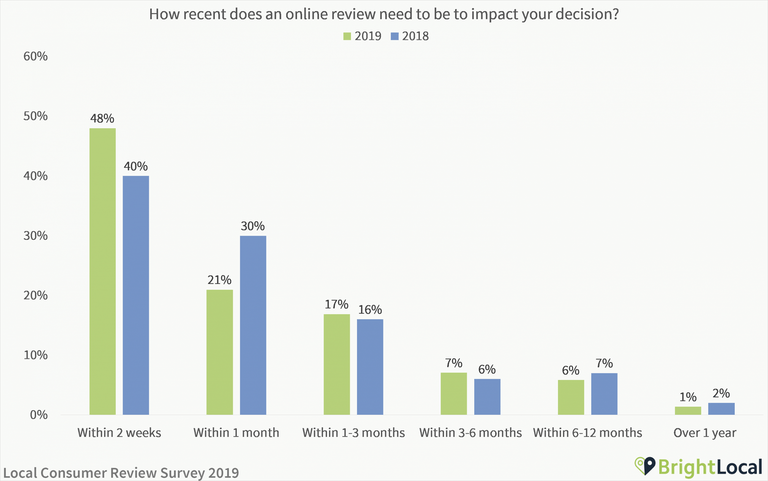
When judging a local business on reviews, what do you pay attention to?

What is your typical next step after you read a positive review?
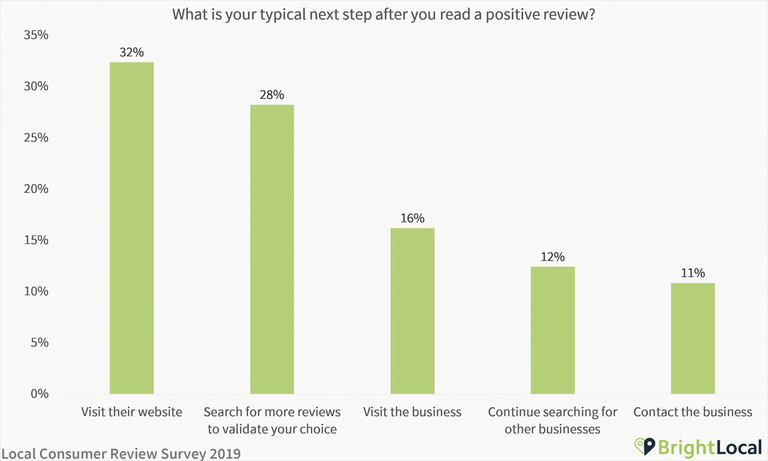
So Where is the Best Place for a Business to Curate Reviews?
The better question to ask is which review platform will have the greatest impact on your SEO efforts. After all, the goal of curating more high quality, positive sentiment reviews is so you can rank higher, gain consumer trust, and attract new customers.
While it’s a good strategy to accumulate reviews on a number of platforms, the general consensus is that reviews on Google and more specifically your Google My Business listing will have the greatest impact on your SEO efforts. After all, Google is the first port of call for the vast majority of all internet searches in the world and has a high level of trust amongst users and businesses.
How Many Reviews do I Need?
Unfortunately, there is no magic number. Some industries are notoriously hard to get reviews in, think of your divorce lawyers and other businesses where confidentiality is important. Other factors like the location and density of businesses in the same area also come into play.
But according to stats from a Google Reviews Study conducted by Bright Local on how many reviews a local business needs, there are some approximate numbers to go by.
- On average, local businesses have 39 Google reviews
- 74% of local businesses have at least one Google Review
- Businesses appearing in Google’s top 3 local positions have an average of 47 Google Reviews
- Bars, restaurants, and hotels are the local businesses most likely to have Google Reviews, and accountants are the least likely
- The average Google Reviews star rating for a local business is 4.42 stars
- Senior living services, car dealerships and hotels have the lowest average Google star ratings
- Only 5% of businesses have a Google average star rating below 3 stars, while 61% have 4-5 stars
The average number of Google reviews by local ranking position.
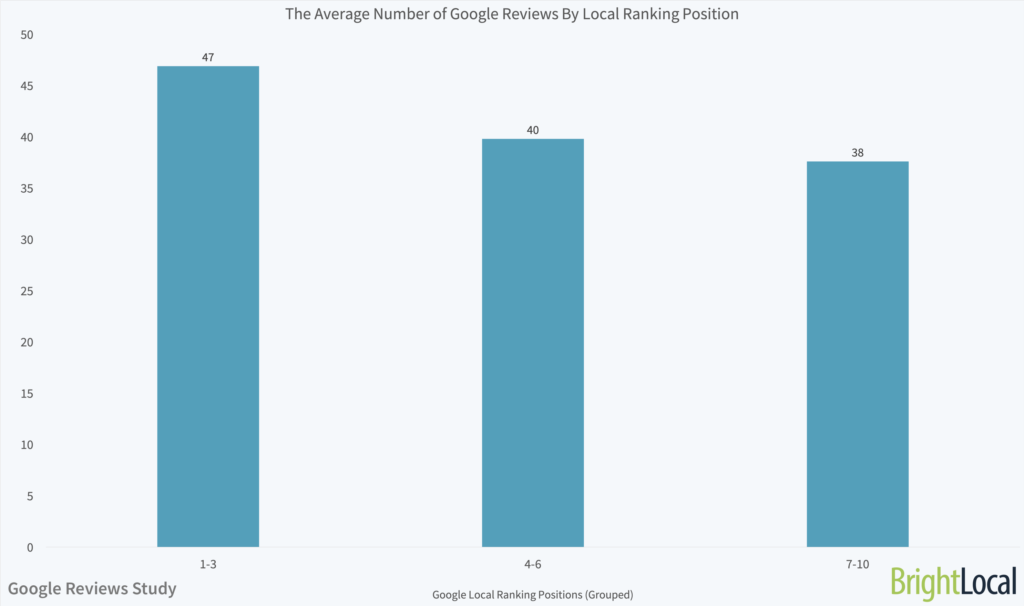
At the end of the day, you want to aim for an overall higher count of reviews and just as important a higher count of positive reviews than your competitors.
If your business has curated reviews in the past but has fallen short when it comes to accumulating recent, 4 and 5-star reviews, below are processes to start building your review generating machine.
Requesting Reviews
When requesting reviews a business has two options, manual and automated. The processes outlined below can be applied to any review platform you wish, but we’ll be putting an emphasis on Google My Business because of the direct impact it has on local rankings.
Manual (Free): This includes sending a templated email to all of your clients once they have completed an interaction with your company.
Automated (Paid): This includes the use of a review tool that automatically sends your customers an email and directs them to your listing to leave a review.
Manual Review Process
- Go here: https://support.google.com/business/answer/7035772?hl=en
- Enter your business name and/or address to get your link. This will generate a direct link for customers to leave a review on your Google My Business Listing, make it easy for the customers and they will leave reviews all day long!
- Save this link in your notepad for easy reference
Any time you finish working with a customer (and you are confident they are happy), then send them an email like this:
Hi there,
I just wanted to say thanks again for being a valued customer of [Company Name]. If you have 2 minutes, I’d really appreciate if you left a review on our Google Listing. Here is the link: [Add link]
Have any feedback for me personally? Feel free to reply to this email and let me know.
Thank you,
[Your name and position]
Conditions:
- Delegate this process to someone customer-facing in your company
- Make this an explicit responsibility for whoever is in charge of it
- Have a specific trigger in your normal invoicing/payment process where these emails are sent (if possible)
- If whoever is responsible isn’t sending these emails consistently enough, then I would recommend blocking off a time in their calendar 1-2 times a week for them to do this
Automated Review Process
The manual process requires someone staying on top of sending out emails. In the day to day of running a business, it can be easy to forget about this.
If you would rather automate the process, there are review generation tools that can be used.
The trade-off here is that they cost money.
If you are looking to save as much as possible, then opt for the manual process above. If you would rather get this set up once and not have to worry about it, then I would recommend the following tool:
GatherUp.com: Plans start at $75 per month. This has become a go-to recommendation for businesses that want to make the review process easier.

Increasing Review Velocity
As we discussed earlier, we should be aiming to curate more recent, positive reviews whenever possible. If your business hasn’t received any recent reviews or it hasn’t been a priority, use these processes to get back on track.
Ready to bolster your review velocity? These two simple strategies will get you there.
Follow-Ups
A popular sales phrase goes something like this:
The money is in the follow-up.
This couldn’t be more true for getting reviews from your customers.
They’ve got lives just like you:
- Maybe they’ve got children screaming at them
- Maybe they’ve got a boss that just came by their desk
- Or maybe they’re checking their phone while binge-watching a Netflix series (we all do it)
Either way, they’ve got other things going on, so your email asking for a review is not on the top of their to-do list.
Follow this process:
3 Days After Initial Request: Follow up with them, asking for the review, and offering your help with any questions.
Hi there,
I just wanted to say thanks again for being a valued customer of [Company Name]. If you have 2 minutes, I’d really appreciate if you left a review on our Google Listing. Here is the link: [Add link]
Have any feedback for me personally? Feel free to reply to this email and let me know.
Thank you,
[Your name and position]
5 Days After Second Request: Send one last follow up. This should state that this will be the last time you ask for a review, and offer your support if they need anything.
Here is an example:
Hi there,
Sorry to bother you again (this is the last time I’ll email you about this). We noticed that you haven’t had a chance to leave a review on our Google listing yet. If you have about 90 seconds to spare, you can do it here: [Add link]
Thanks again for your business 🙂
[Your name and position]
Conditions:
If you aren’t using any sort of automation, remembering to send follow-ups every 3 and 5 days can be challenging.
If this is the case, then do this:
- Block out 30 to 45 minutes in your calendar on Monday and Friday afternoon
- Send your review requests (and any follow-ups) during this time
Some other conditions:
- Don’t send these emails over weekends or on holidays
- If you have the option of sending a follow-up email sooner (before 3 or 5 days) or later – then go with later. Reviews are important, but keeping your customers happy is the priority
Offer an Incentive
Google does not explicitly say you can’t offer your customers a small gift for leaving a real review of their experience.
If you want to push your customers over the edge – and build even more goodwill with them in the process – then offering something in return for a review can really ramp up your velocity.
How much should you offer for each review? This depends on the value of the review to your business.
If you have many customers where reviews have not been a problem, but just want to boost velocity, then offering a $10 to $20 gift card is enough.
If you run a lower-volume business (maybe you’re a law firm with a small number of high revenue clients) then offering a higher amount is more effective ($50 to $75).
Conditions:
- Do not offer a discount to your own company for leaving a review
This comes off as a ploy to get people who have already done business with you to come back – even though you’re asking them to do a favor for you.
Getting Reviews in Sensitive Markets
This is currently the best way to consistently generate reviews in markets where customers don’t want to openly talk about their experiences.
There are markets where reviews are very difficult to get.
Customers don’t want to publicly talk about their messy divorce, and how your services helped make it all a little less painful.
As a business operating in these markets, we need to be empathetic. Right out asking for a review based on intimate details is the opposite of that. Instead, try the following as it can be pretty effective.
Create a Free “Safe” Offer
For businesses in sensitive industries like legal and medical, creating free tools, guides or resources that focus on truly helping people when they’re just trying to figure things out can go along way, and get you a 5-star review.
While this alone can be a great customer acquisition tool (the people you help will naturally want to do business with you) it has the added benefit of being a first interaction with your business.
Here is how it works:
- Create a resource (a checklist, cheat sheet, guide, etc.) that helps your ideal prospects solve a problem
- Offer that resource to people if they provide their name and email address
- Send them the resource via email
- Follow up with them after 3 days asking for a review (using the review processes included)
A lot of people think reviews need to come from paying customers only. That’s not true at all. Legitimate reviews can come from anyone who has been positively impacted by your company.
Conditions:
- Do not send review requests on the weekends
- Combine this with the processes for getting reviews and boosting review velocity
Responding to Reviews
Let’s start off by saying, all review, even the good ones need a response. Studies have shown that people trust online reviews as much as they trust reviews from family members.
Leaving a response to a positive review not only makes the customer feel that much better about you and your business, but it also shows others that you care.
Negative reviews are where the real work comes in. It’s natural for all businesses to experience negative reviews as we all drop the ball sometimes or a customer is just having a bad day. The important thing to do when this happens is to respond quickly and understand your reply is not necessarily about the person who left the review but rather the entire world of people looking to see how you handled a bad situation.
Yes, do your due diligence and follow up with the customer and try to make it right but your response needs to let everyone know you care.
Negative review response checklist:
- Don’t use the same canned response for all review, positive or negative
- Be empathetic
- Be honest and real. If it was the businesses fault that the ball got dropped let everyone know how you made it right
